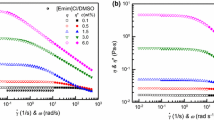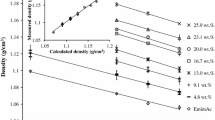Abstract
Rheological behavior of the concentrated cellulose/1-butyl-3-methylimidazolium chloride ([BMIM]Cl) solutions was investigated. As polymeric fluid, solutions of cellulose in [BMIM]Cl display a marked elastic behavior under shear flow. The dependence of the shear viscosity η, and of the dynamic modulus, on concentration, average degree of polymerization (DP) and temperature is discussed. At lower concentrations and degrees of polymerization (DP), cellulose solutions show viscous, inelastic behavior at low frequencies and low shear rate. At higher concentration and DP, cellulose solutions are more elastic at higher frequencies and shear rate. Such solutions also have some usual rheological properties. The dynamic rheological responses revealed that the Cox–Merz rule did not hold for these cellulose solutions at high deformation rate. Plotting storage modulus G′ against loss modulus G″ gave almost a master curve which is independent of temperature and concentration, with the slope of about 1.651 for 10 wt% cellulose solutions. This value indicates the existence of microheterogeneity in the solution system.











Similar content being viewed by others
References
McCormick C, Callais P, Hutchinson B (1985) Solution studies of cellulose in lithium chloride and N,N-dimethylacetamide. Macromolecules 18:2394
Schweiger H, Richard G (1969) Solvation of cellulose and other polysaccharides. Chem Ind (London) 10:296
Johnson D, Nicholson M, Haigh F (1976) Dimethyl sulfoxide/paraformaldehyde: a nondegrading solvent for cellulose. Appl Polym Symp 28:931
Zhang L, Ruan D, Gao S (2002) Dissolution and regeneration of cellulose in NaOH/thiourea aqueous solution. J Polym Sci, Part B: Polym Phys 40:1521
Gagnaire D, Mancier D, Vincendon M (1980) Cellulose organic solutions: a nuclear magnetic resonance investigation. J Polym Sci Polym Chem Ed 18:13
Blachot J, Brunet N, Navard P, Cavaille J (1998) Rheological behavior of cellulose/monohydrate of n-methylmorpholine n-oxide solutions. Part 1: liquid state. Rheol Acta 37:107
Petrovan S, Collier J, Morton G (2000) Rheology of cellulosic N-methylmorpholine oxide monohydrate solutions. J Appl Polym Sci 77:1369
Navardd P, Handin J (1980) Rheology of mesomorphic solutions of cellulose. Br Polym J 12:174
Kima S, Shina W, Choa H, Kimb B, Chunga I (1999) Rheological investigation on the anisotropic phase of cellulose–MMNO/H2O solution system. Polymer 40:6443
Chae D, Kim B, Lee W (2002) Rheological characterization of cellulose solutions in N-methyl morpholine N-oxide monohydrate. J Appl Polym Sci 86:216
Navard P, Haudin J, Quenin I, Peguy A (1986) Shear rheology of diluted solutions of high molecular weight cellulose. J Appl Polym Sci 32:5829
Han J, Feng D, Choi-Feng C, Han C (1995) Effects of sample preparation and flow geometry on the rheological behaviour and morphology of microphase-separated block copolymers: comparison of cone-and-plate and capillary data. Polymer 36:155
Petrovan S, Collier J, Negulescu I (2001) Rheology of cellulosic N-methylmorpholine oxide monohydrate solutions of different degrees of polymerization. J Appl Polym Sci 79:396
Swatloski R, Spear S, Holbrey J, Rogers R (2002) Dissolution of cellulose with ionic liquids. J Am Chem Soc 124:4974
Remsing R, Swatloski R, Rogers R, Moyna G (2006) Mechanism of cellulose dissolution in the ionic liquid 1-n-butyl-3-methylimidazolium chloride: a 13C and 35/37Cl NMR relaxation study on model systems. Chem Commun 1271
Ren Q, Wu J, Zhang J, He J, Guo L (2003) Dissolution of cellulose with ionic liquids. Acta Polym Sin 448
Hermanutz F, Gahr F, Uerdingen E, Meister F, Kosan B (2008) New developments in dissolving and processing of cellulose in ionic liquids. Macromol Symp 262:23
Kuang Q, Zhao J, Niu Y, Zhang J, Wang Z (2008) Celluloses in an ionic liquid: the rheological properties of the solutions spanning the dilute and semidilute regimes. J Phys Chem B 112:10234
Rao M (1990) Rheology of fluid and semisolid foods principles and applications. Aspen Publishers, Gaithersburg, MD
Tam K, Jenkins R, Winnik M, Bassett D (1998) A structural model of hydrophobically modified urethane-ethoxylate (HEUR) associative polymers in shear flows. Macromolecules 31:4149
Bokias G, Hourdet D, Iliopoulos I (2000) Positively charged amphiphilic polymers based on poly(N-isopropylacrylamide): phase behavior and shear-induced thickening in aqueous solution. Macromolecules 33:2929
Ahn K, Osaki K (1994) A network model for predicting the shear thickening behavior of a poly(vinyl alcohol)-sodium borate aqueous solution. J Non-Newtonian Fluid Mech 55:215
Han C, Kim J, Kim J (1989) Determination of the order–disorder transition temperature of block copolymers. Macromolecules 22:383
Acknowledgements
The work is supported by a grant from the Ministry of Education of the People’s Republic of China (Grant No. 707026), Science and Technology Commission of Shanghai Municipality (Grant No. 08XD14005) and Shanghai Leading Academic Discipline Project (Grant No. B603).
Author information
Authors and Affiliations
Corresponding author
Rights and permissions
About this article
Cite this article
Chen, X., Zhang, Y., Cheng, L. et al. Rheology of Concentrated Cellulose Solutions in 1-Butyl-3-methylimidazolium Chloride. J Polym Environ 17, 273–279 (2009). https://doi.org/10.1007/s10924-009-0149-4
Published:
Issue Date:
DOI: https://doi.org/10.1007/s10924-009-0149-4




